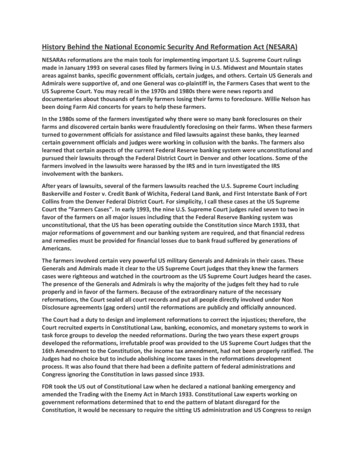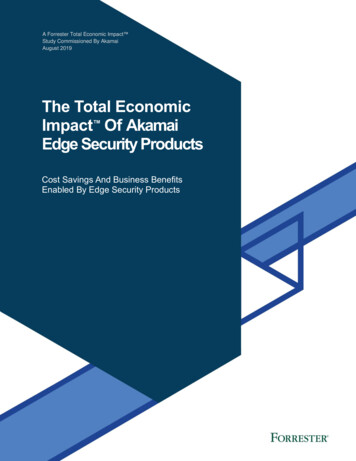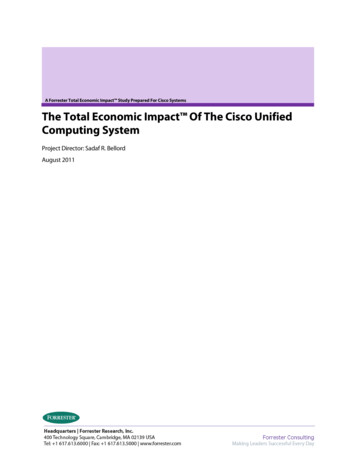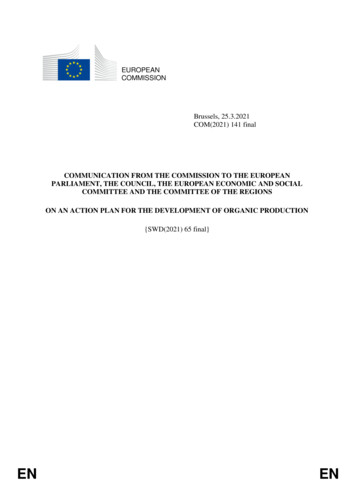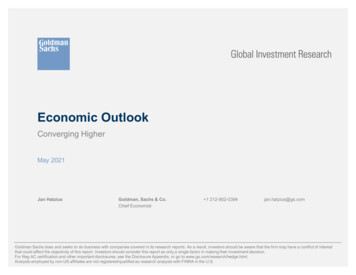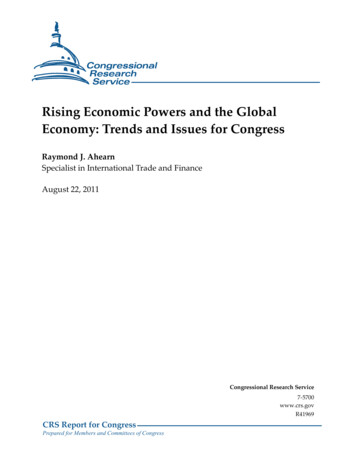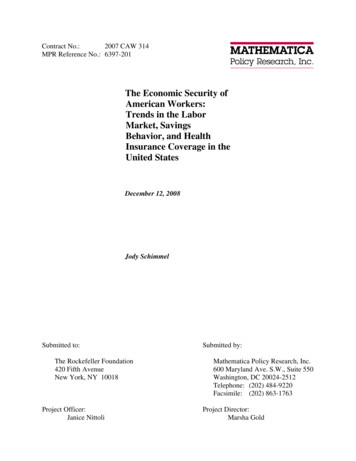
Transcription
Contract No.:2007 CAW 314MPR Reference No.: 6397-201The Economic Security ofAmerican Workers:Trends in the LaborMarket, SavingsBehavior, and HealthInsurance Coverage in theUnited StatesDecember 12, 2008Jody SchimmelSubmitted to:The Rockefeller Foundation420 Fifth AvenueNew York, NY 10018Project Officer:Janice NittoliSubmitted by:Mathematica Policy Research, Inc.600 Maryland Ave. S.W., Suite 550Washington, DC 20024-2512Telephone: (202) 484-9220Facsimile: (202) 863-1763Project Director:Marsha Gold
ACKNOWLEDGMENTSThis report is an updated version of a draft produced in May 2008 for the RockefellerFoundation. While much has transpired in the U.S. economy since then, the annual statistics usedin this report do not lend themselves to updating yet; therefore, this report does not capture theeconomic downturn and recession in 2008. If this report is updated in 2009, data from 2008 willbetter reflect the deteriorating economic position of many Americans.This work greatly benefited from feedback from Marsha Gold, a senior fellow and theproject director at Mathematica Policy Research (MPR) for the evaluation of the RockefellerFoundation’s Campaign for American Workers, and from Deborah Chollet, a senior fellow atMPR. Their comments were instrumental in framing the problem, as well as for identifying themost appropriate data sources for some of the measures contained in this report. All errors andomissions remain the author’s responsibility.iii
CONTENTSChapterPageOVERVIEW . viiiIBACKGROUND .1A.IIIIIIVMETHODOLOGY FOR SELECTING REPORTED MEASURES OFECONOMIC SECURITY .2U.S. WORKFORCE TRENDS.4A.LABOR FORCE PARTICIPATION .4B.LABOR UNION REPRESENTATION .6C.FIRM SIZE .6D.EMPLOYMENT ARRANGEMENTS .8ELEMENTS OF SECURITY: RESILIENCE TO WEATHER SHORT-TERMINCOME FLUCTUATIONS .12A.PERSONAL SAVINGS RATES .12B.POVERTY AND INCOME INEQUALITY .13C.UNEMPLOYMENT.16D.INTEREST RATES.17E.HOMEOWNERSHIP .18ELEMENTS OF SECURITY: RETIREMENT SAVINGS .21A.PENSION OFFERS, ACCESS, AND TAKE-UP .21B.SOCIAL SECURITY RETIREMENT AND MEDICARE .23C.ADEQUACY OF HOUSEHOLD RETIREMENT SAVINGS .26D.INSURANCE COVERAGE OF RETIREES .28iv
CONTENTS (continued)ChapterVVIPageELEMENTS OF SECURITY: HEALTH CARE COVERAGE ANDPROTECTION .31A.OFFERS OF COVERAGE, BY FIRM SIZE .32B.HEALTH INSURANCE COVERAGE OF WORKERS .33C.EMPLOYER-SPONSORED HEALTH INSURANCE COSTS.37CONCLUSION AND NEXT STEPS .40APPENDIX A: PRIMARY AND SECONDARY DATA SOURCES .41v
FIGURESFigurePageII.1LABOR FORCE PARTICIPATION AMONG MEN AND WOMEN,1950-2007 .5II.2FRACTION OF THE LABOR FORCE WITH UNION REPRESENTATION,2000-2007 .7II.3FRACTION OF THE LABOR FORCE BY EMPLOYER FIRM SIZE,1993-2004 .8II.4FRACTION OF THE LABOR FORCE ENGAGED IN SELF-EMPLOYMENTAND PART-TIME WORK, 1993-2007 .9II.5NON-STANDARD EMPLOYMENT ARRANGEMENTS, 1995-2005.11III.1AGGREGATE PERSONAL SAVINGS RATES, 1993-2006 .13III.2POVERTY RATES, 1993-2006 .14III.3INCOME GAPS BETWEEN LOWER AND HIGHER INCOMEHOUSEHOLDS, 1993-2006 .15III.4UNEMPLOYMENT RATES 1993-2007 .17III.5TEN-TEAR TREASURY BOND AND FEDERAL FUNDS RATES,1993-2007 .18III.6HOMEOWNERSHIP RATES, 1994-2005 .19III.7RATIO OF HOME VALUE TO INCOME, 1997-2005 .20IV.1PREVALENCE OF DB AND DC PLANS, 1993-2004 .22IV.2ACCESS AND PARTICIPATION IN RETIREMENT PLANS, 2003-2007 .24IV.3SOCIAL SECURITY AS A PERCENTAGE OF TOTAL RTIREMENTINCOME FOR INDIVIDUALS, 2003-2006 .24IV.4MONTHLY MEDICARE PART B PREMIUMS AS A FRACTION OF THESOCIAL SECURITY AVERAGE RETIREMENT BENEFIT, 1999-2006 .26IV.5FRACTION OF HOUSEHOLDS AT RISK OF NOT BEING ABLE TOFINANCE AN ADEQUATE LEVEL OF CONSUMPTION INRETIREMENT, 1983-2004 .28vi
FIGURES (continued)FigurePageIV.6OFFERS OF EMPLOYER-SPONSORED HEALTH INSURANCECOVERAGE FOR RETIREES, 1997-2005 .29V.1OFFERS OF HEALTH INSURANCE, BY FIRM SIZE, 1999-2007.32V.2HEALTH INSURANCE COVERAGE OF WORKERS, BY SOURCE,1993-2006 .33V.3FRACTION OF WORKERS COVERED BY EMPLOYER-SPONSOREDCOVERAGE IN THEIR OWN NAME, 1993-2006 .35V.4FRACTION OF WORKERS COVERED BY EMPLOYER-SPONSOREDCOVERAGE AS A DEPENDENT, 1993-2006 .36V.5LACK OF HEALTH INSURANCE COVERAGE AMONG WORKERS,1993-2006 .37V.6SHARE OF THE TOTAL HEALTH INSURANCE PREMIUM BORNE BYWORKERS, 1999-2007 .38V.7INCREASE IN HEALTH INSURANCE PREMIUMS COMPARED TOOVERALL INFLATION AND WORKERS’ WAGES, 1993-2005 .39vii
OVERVIEWThe Rockefeller Foundation’s Campaign for American Workers (CAW) aims to focusattention on a revised Social Contract for the 21st century with the goal of enhancing economicsecurity across the United States. As its name suggests, the CAW focuses on workers, that is,working households and individuals with an attachment to the labor force, even if not currentlyemployed. Economic security, for purposes of the Initiative, is defined in three ways: (1) shortterm savings or other means of creating resilience to weather short-term income fluctuations; (2)adequate retirement savings and associated post-retirement income streams; and (3) healthinsurance coverage to protect workers from the financial risk of illness. The RockefellerFoundation is especially interested in change that will affect low- to moderate-income workersand, as such, racial and ethnic subgroups that have historically been less economically secure.The Rockefeller Foundation (RF) has awarded Mathematica Policy Research, Inc. (MPR), agrant to evaluate the CAW, with a particular emphasis on formative timely feedback on strategyand initiative development. To provide context for the evaluation, MPR undertook an analysis ofwhat is known about relevant baseline trends in economic security from publicly availablenational statistics. This brief summarizes the main findings of that review.Main Findings and TrendsFrom the early 1990s to the mid 2000s, the circumstances faced by workers were favorablyinfluenced by a strong economy in the United States—low levels of general inflation, high ratesof employment, low interest rates, high rates of homeownership, and declining poverty across allracial and ethnic groups. But now, as the U.S. economy is in the midst of a recession, theseconditions are eroding and workers are experiencing very different circumstances. 1Even with a strong economy over much of the 1990s and early 2000s, labor market changesleft more workers to fend for themselves, with less support from employers. The shift in pensionofferings from defined benefit (DB) to defined contribution (DC) plans has elevated the risk ofretirement income insecurity. DB plans assure retirees of a fixed annuity payment from theirformer employer (contingent on meeting requirements about length of service and retirementage), while DC pension payouts depend on the amount contributed by the worker over his or herworking years and the wisdom of their investments. Because employers often match theemployee’s contribution, these plans promote greater employment mobility for workers, but theyrequire personal saving on the part of the worker and are susceptible to workers drawing downtheir retirement savings when they change jobs. While many current retirees have DB plansdating to decades past, future retirees are much more likely to rely only on asset accumulation inDC plans.1The National Bureau of Economic Research (NBER), which determines whether the U.S. economy is in arecession, released evidence in December 2008 that the economy has been in a recession since USTRE4B05YX20081201.viii
Health insurance coverage for workers and retirees has also changed since the early 1990s.Offers of health insurance coverage for retirees fell sharply in the last decade; in 1988, 66percent of firms with 200 or more workers offered retiree health benefits to their workers; thisfell to 34 percent by 2002 (Weller, Wenger, and Gould 2004). Because retiree health insurancecoverage provides important financial protection from loss of assets to finance retirement, asignificant decline in retiree coverage further reduces the prospect of retirement security amongolder workers.Employer-based health insurance covers about two-thirds of Americans under age 65,though fewer than half of workers have health insurance coverage from their own employers,instead receiving coverage as a dependent. Those with employer-based coverage are payingincreasing amounts out-of-pocket for health insurance premiums and co-payments. Theseincreasing costs likely contribute to the documented decline in employee take-up of offeredcoverage and increasing rates of uninsurance nationwide.Evidence on short-term savings is harder to find, and the available statistics paint a lessconsistent picture of economic security in this area. Increasing health care costs and newobligations to save for retirement may erode the ability of working households to save foremergencies and other short-run needs, especially among households living from paycheck topaycheck. The aggregate U.S. savings rate has been falling and relatively low since around 1980,and may fall even further as rising prices and difficulties in the financial markets affect thepurchasing power of Americans. Low interest rates since 2000 have allowed additional people topurchase homes, which may have resulted in increased savings in the form of housing equity inthe long run, though with housing values plummeting in many places during 2007 and 2008,these gains may not be realized in the short run.Overall, national indicators show that certain aspects of economic security of workers haveeroded, and it is unclear whether households can adapt to changes in the social contract byaltering their spending and savings behavior. The tracking of trends in the indicators discussed inthis report will help identify the additional pressures on working households and may point toevidence of improvement in some areas. Understanding the dynamics of economic security mayallow the CAW to target its efforts effectively in an evolving environment.Relevance to the Initiative and Future WorkThe information presented in this document may be used for two main purposes related tothe CAW. First, it provides context to the Initiative as it is rolled out, identifying areas whereworkers’ economic security may be eroding or where anecdotes or hypotheses are not borne outin empirical evidence. Second, as the information is updated, it will track trends in economicsecurity over the life of the Initiative. This tracking will help identify macroeconomic trends thatmight influence the ability of the CAW to have its desired effect (i.e., a recession may stall anyimprovements in short-term savings over the period). Further, tracking may allow for someanalysis of the effect of the CAW. Although it will be virtually impossible to link observedimprovements in economic security causally to the activ
Janice Nittoli . Submitted by: Mathematica Policy Research, Inc. 600 Maryland Ave. S.W., Suite 550 . Washington, DC 20024-2512 . Telephone: (202) 484-9220 .
